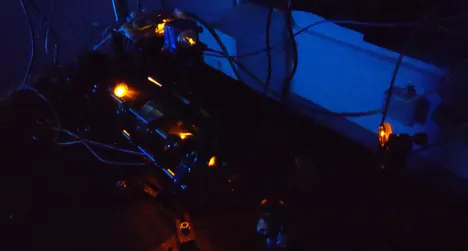Sodium Magnetometry
Project idea
In our sodium magnetometry lab we are developing the tools for a satellite-based measurement of Earth's magnetic field. Contrary to the common approach placing magnetometers on a satellite (typically orbiting Earth in >200km altitude), our goal is using a laser and detector system located on a nano satellite, actually measuring Larmor precession of atoms in the 5-10km thick sodium layer of Earth's mesosphere in about 90km altitude.
Orange light of wavelength 589nm from a laser on the satellite excites sodium atoms in the mesosphere at their Larmor frequency of about 260kHz (gyromagnetic ratio of sodium: 6.99812 Hz/nT). A detector system on or attached to the satellite captures fluorescence light emitted by the sodium atoms. Magnetic field information is then decoded from this signal. While the satellite orbits Earth it continuously acquires the magnetic field measurements generating a global map of Earth's magnetic field.
So far Earth's magnetic field is only monitored on ground-level or measured using sensors on satellites (>200km altitude) providing highly valuable data of geological and geodestic interest, but also for navigation. A complete map of the magnetic field in Earth's mesosphere has never been done before, complements available data and triggers new research opportunities.
Sodium Lab
In a small Earth-based setup we are testing optical magnetometry of sodium vapour resempling various conditions similar to the mesosphere in terms of pressure, density, optical depth, etc. For this we use different glass cells filled with sodium. The cells vary in geometry, with a length of up to 300mm, and are placed in a temperature-controlled oven to adjust the sodium vapour pressure. The pump (and probe) light is generated by a small laser module emitting up to 50mW at a wavelength of 589nm, which we also plan to stabilize using a dichroic atomic vapour laser lock (DAVLL).
Magnetic field information is encoded in the fluorecence light emitted by the excited sodium layer in the mesosphere (or from the sodium vapour inside a glass cell in the lab). In space this light will be detected by silicon photo multipliers (SiPM) using small-bandwidth optical filters, hence in the lab we will also evaluate this detection method, together with optical detection using a low power probe light beam.
In the lab we're able to learn more about the signal amplitude from the mesospheric sodium layer imitating in-space conditions. However, an important figure is the background noise to expect from other sources and to evaluate this we are planning to send a detection system to the International Space Station (ISS) recording actual data while orbiting Earth.
Thesis topics
For possibile thesis topics please see contact information below.
Contact
Dr. rer. nat. Florian Kuchler
- Tel.: +49 (89) 289 - 53712
- Raum: 5101.EG.295
- florian.kuchler@tum.de
